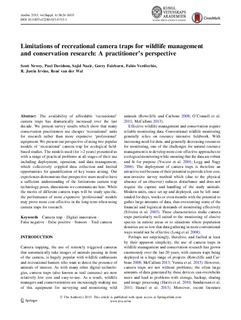Limitations of recreational camera traps for wildlife management and conservation research: A practitioner’s perspective
Newey, Scott; Davidson, Paul; Nazir, Sajid; Fairhurst, Gorry; Verdicchio, Fabio; Irvine, R. Justin; van der Wal, Renè
Journal article, Peer reviewed

Åpne
Permanent lenke
http://hdl.handle.net/11250/2382929Utgivelsesdato
2015Metadata
Vis full innførselSamlinger
Originalversjon
Newey, S., Davidson, P., Nazir, S., Fairhurst, G., Verdicchio, F., Irvine, R. J., & van der Wal, R. (2015). Limitations of recreational camera traps for wildlife management and conservation research: A practitioner’s perspective. Ambio, 44, 624-635. doi10.1007/s13280-015-0713-1 10.1007/s13280-015-0713-1Sammendrag
The availability of affordable ‘recreational’
camera traps has dramatically increased over the last
decade. We present survey results which show that many
conservation practitioners use cheaper ‘recreational’ units
for research rather than more expensive ‘professional’
equipment. We present our perspective of using two popular
models of ‘recreational’ camera trap for ecological fieldbased
studies. The models used (for[2 years) presented us
with a range of practical problems at all stages of their use
including deployment, operation, and data management,
which collectively crippled data collection and limited
opportunities for quantification of key issues arising. Our
experiences demonstrate that prospective users need to have
a sufficient understanding of the limitations camera trap
technology poses, dimensions we communicate here. While
the merits of different camera traps will be study specific,
the performance of more expensive ‘professional’ models
may prove more cost-effective in the long-term when using
camera traps for research.